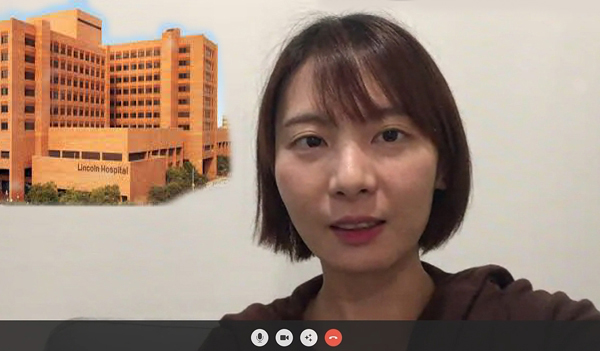In the State of New York, relatively young doctors infected with the new coronavirus and showing mild symptoms have no choice but to see patients with masks on, a medical resident there said.
They usually get a single N95 mask per five days, she said, adding that not only masks and surgical gowns but treatment materials are running out fast.
Shin Ji-hye, a third-year resident for internal medicine at Lincoln Medical and Mental Health Center in Bronx, New York, described the dire situation during an online video interview with Korea Biomedical Review.

The U.S. had about 454,600 confirmed cases, 29 percent of the global number at 1.57 million as of Thursday. The COVID-19 pandemic hit New York State particularly hard. The state’s diagnosed cases surpassed 159,000, and the death toll exceeded 7,000.
Shin, who graduated from a medical school in Korea and went to the U.S. for residency training, is at the center of the COVID-19 crisis.
The Lincoln Medical and Mental Health Center has turned to a hospital almost exclusively for COVID-19 patients. The hospital’s 150 beds, available for the use of ventilators out of 300 beds, are being occupied by COVID-19 patients. The hospital plans to increase the number of ventilator-available beds to 250, according to Shin.
She said the shortage of medical supplies and medical staff made her struggle the most.
“At first, we were short of masks for surgery but the situation got better after donations. Next, we ran out of N95 masks and the hospital told us to use one mask for five days,” she said.
Checking if there is any insufficient material when arriving at work has become a habit for Shin. However, there were still some missing supplies unexpectedly, she said.
Shin noted that all the medical staff was new to COVID-19 and that they were sharing updated papers and adjusting to new developments. “It is quite challenging because there is no protocol or guideline to follow when seeing COVID-19 patients. Doctors have to decide on their own,” she said.
She also said the number of confirmed cases in healthcare professionals was increasing. On the day she had the video interview, her colleague nurse died from COVID-19.
At her hospital, the medical staff was grouped in five or six people, or up to 10, including trainees, to work together or self-isolate together.
At the initial stage of the COVID-19 outbreak, the hospital made the medical staff who contacted confirmed patients self-quarantine for two weeks. As time passed, there was no health worker to stay at the hospital, she said.
“The hospital told us to stay at home for two weeks but called us again. Health workers with mild COVID-19 symptoms wear masks and see patients. If symptoms get worse, they can take a rest. But most of them just work,” she went on to say.
As it was extremely difficult to get medical workers, the hospital was hiring doctors or nurses in travel with high salaries, she added.

